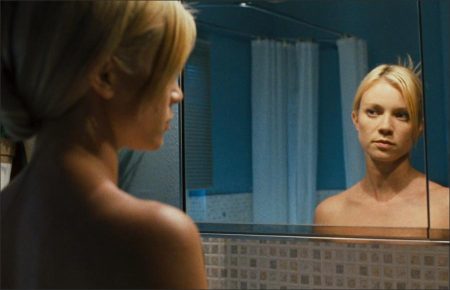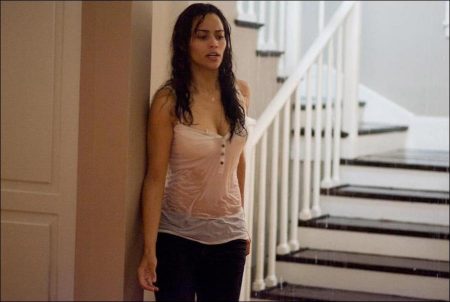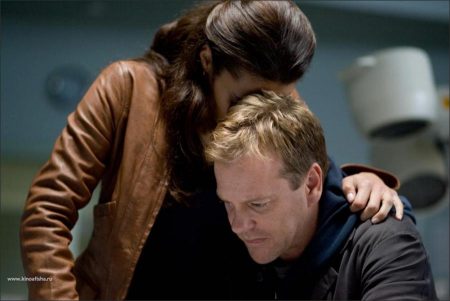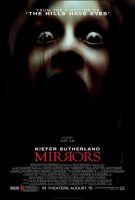Mirrors Movie Trailer. Rife with suspense and rich with disquieting atmosphere, “Mirrors” is fortified by an evocative production design that portends the horrific journey that awaits Ben Carson and his family. Mirrors was filmed almost entirely in Bucharest, Romania, with the exception of key exteriors, which were shot in New York. Bucharest was selected by the filmmakers because of its formidable Academy of Sciences building, a massive structure commissioned by oppressive Communist leader Nikolae Ceausescu, which was left unfinished following his death in 1989.
Writer-director Alexandre Aja envisioned the Academy as the setting for the ominous, fire-ravaged Mayflower department store. “This building is so phenomenal, it could not be recreated on a stage,” says Aja, who had visited the location several years ago while scouting for another film. “The atmosphere here is so filled with fear and tension, we knew we could capture something really unique.”
“Ceausescu frightened and traumatized more people than we’ll probably scare with this movie,” notes producer Alexandra Milchan. “You can feel the tension in this building. It still has his imprints on it.”
While the site easily lent its imposing scale and sinister history to the creation of the Mayflower set, production designer Joseph Nemec III (“The Hills Have Eyes,” “T2: Judgment Day”) and his art department faced major challenges in transforming 20,000 square feet of raw institutional architecture into the ruined opulence of a world-class department store.
From the grand staircase to the display cases, every aspect of the sprawling floor plan had to be designed, sculpted, fabricated and dressed in a mere 12 weeks – on the 6th floor of the abandoned Academy, which has no elevators.
This process included fire-torching every inch of the store that the fictitious blaze would have devoured. Two teams of torchers burned everything from walls, floors, furniture and draperies to a full compliment of the store’s “stock” – including clothing, watches, jewelry, housewares and cosmetics.
Particular attention was paid to the posing and decomposing of the mannequins, as a way of evoking the Mayflower’s former vitality and stature, as well as representing the evil that lurks within the store. “The mannequins give you a sense that there is some life left in this burned-out place,” Nemec explains. “We dressed them and put them in very lifelike positions, and then tried to burn and distress them in a way that underscores the tragedy of the lives that have been trapped behind the mirrors. One we called our David, because he held a very regal pose despite all the fabric around him being burned away. Another was called Freckles, because we torched its coating until it bubbled up, which symbolizes the emotions inside completely burning out.”
The strategic burning of the set was followed by a thorough dousing, courtesy of the “water team.” Painters then added layers of water “staining” to achieve the authentic look of a scorched structure that has been left to ruin by rain and neglect for five years. Additionally, wood shavings were burned and then blanketed throughout the set, creating a thick carpet of soot. The results were disturbingly realistic, both visually and aurally.
“There is a company in New York that supplies scents, everything from dirty socks to fresh roses,” says Nemec, who typically infuses his sets with aromas appropriate to each locale. “But in this case, I didn’t need to use them because we created a ‘burnt building smell’ ourselves!”
The dank, heavy odor and highly detailed authenticity of Nemec’s rotted-out set brought a unique texture and intensity to the production, according to Aja. “Shooting for weeks in the broken glass and dust, with the smell of smoke and fire hanging in the air, created an atmosphere for the actors and crew that made everyone feel how scary it would be to find yourself alone in this place, with only a flashlight to guide you through the darkness.”
“As an actor, when you come onto a set that is as real and pliable as this one is, there is an incredible amount of freedom,” says Kiefer Sutherland, who is accustomed to working within the confines of smaller scale environs on his hit television series “24.” “This set is 360 degrees, so if I want to do a full circle, if I want to move in this direction or that direction, I can. I don’t have to worry about a wall missing over here. It’s just fantastic.”
The scope of the set and the murky darkness that cloaks it presented a career challenge for cinematographer Maxime Alexandre (“The Hills Have Eyes”). “It’s definitely the biggest location I’ve ever lit, and it’s brimming with black walls,” he says, noting that the only sources of realistic natural light in the environment are the large windows at the store’s main entrance and the holes punched into the shattered panes of the dome roof by weather and time. “We used really high, strong lights to ‘un-stick’ silhouettes and objects from each other, and to create some depth of field and distance between the actors, the mirrors and their reflections.”
The ornate, 30-foot mirrors that adorn the Mayflower walls were positioned to amplify the magnitude of the space and reflect the horror, loss and desolation that pervade it. But from a practical standpoint, shooting a movie that revolves around mirrors is a filmmaker’s nightmare.
“When you’re a DP and you receive a script titled ‘Mirrors,’ it’s like a huge taboo,” Alexandre says. “Each frame is a gamble when you put the camera in front of a mirror. You’re always at the edge of your reflection.”
This was especially true of this production, as Aja and Alexandre went well beyond mirrors in crafting shots that capture reflections off an array of ordinary surfaces – windows, TV screens, stainless steel fixtures, picture frames, floors, water – each more complicated to film than the next.
“We knew from the beginning that it was going to be very difficult,” Aja acknowledges, “but I think we managed to use mirrors and reflective surfaces in a way that no one has ever done before.”
“Watching Alex pick up reflections off of everything was fascinating,” Sutherland enthuses. “He has incredible imagination. Every day I came to work, I saw something new. The story was revealing itself to me in a really fresh way.”
To facilitate the filming of scenes that involved flooding the Carson residence and picking up reflections in the water’s surface, Nemec’s team built the set for the modest home on a water tank, using double-curved fiberglass walls and sealed flooring that could be filled and drained as needed. (Nemec chose dark colors for the floors to intensify the reflective effect.) Removable sections of flooring were installed for a climactic sequence in which young Michael Carson is yanked through his reflection and disappears into a thin layer of water coating the floor.
As complex as it was to design a functional water set like the Carson house, Nemec found it equally taxing to make it look like a typical New Jersey family home. “Finding furniture and household objects in Bucharest, Romania that we could adapt to look like typical American décor was quite a challenge,” the designer reports.
Sutherland was impressed by his stay in the nascent country’s capital. “Romania may be a young country from our perspective, but you’re talking about one of the most well-educated societies in the world, with a 97% literacy rate,” he notes. “There are five year-olds running around who can kick my ass in chess. You have incredible writers and filmmakers here. Romania just won the Palme d’Or at Cannes, and joined the European Union. Yet it’s struggling to find its new identity. It’s going through a massive transition, politically and economically. It’s a very exciting time here. Did that affect the process of making the film? Absolutely.”
Like their efforts to capture reflections in a new and exciting way, the filmmakers strived to render as many visual and special effects as possible through practical means, rather than rely heavily on digital VFX in post production.
One of the film’s most gruesome visuals – when the reflection of Ben’s sister Angela forces her to rip her jaw off of her face – was achieved through an elaborate prosthetic makeup created by Mike McCarty and Jaremy Aiello of K&B Effects (“The Hills Have Eyes,” “24”).
“We were tossing and turning for weeks over how to make it look like this character doesn’t have a jaw anymore,” McCarty admits. “For reference, I found a Civil war photo of a soldier who got hit in the mouth with a cannonball, but it looked really fake. We also looked at newspapers that don’t censor gory photos, but the real stuff tends to look fake.”
“If we actually did it the way it looks in real life,” adds Aiello, “people would say ‘That looks stupid!'”
Staging the fiery implosion of the secret “Mirror Room” involved blasting apart an intricate puzzle of mirrors 10 feet by 6 feet wide with controlled explosives, and choreographing a tunnel collapse around Ben Carson as he races to escape the wrath of Anna, a powerful demon unleashed by the explosion.
Safety was of utmost concern, as Sutherland insisted on doing many of his own stunts, including Carson’s battle with Anna and his treacherous escape through fire, raging water, multiple explosions and debris crashing all around him. “Timing was of the essence,” says special effects supervisor Jason Troughton. “Kiefer wanted to be right in there with the flames almost licking his ears. His timing was precise from rehearsals through each take, and my team’s timing was impeccable as well.”
“Kiefer is such a hardworking actor,” says Paula Patton, who stars opposite Sutherland as Ben Carson’s estranged wife Amy. “He believes in what he’s doing to the Nth degree. When you’re working with a partner who is that committed, it makes your job so much easier and more fulfilling.”
“Kiefer is amazing,” Aja marvels. “He has so much talent and experience. The subtle changes he brought to each take made the evolution of his character even more organic and compelling. Working with Kiefer was the best experience I’ve had with an actor.”
That so many of the film’s intricate visual and special effects were achieved with minimal digital augmentation is a testament to the creativity and craftsmanship of Aja and his “Mirrors” production team. “Alex is a stylistic genius, and he has a such beautiful rhythm for suspense,” Sutherland says. “When most people stay in the middle of the road, he’s always to the left or the right. We believe in the same ideals in terms of storytelling, and I have such confidence in him. This has been one of the great collaborations of my career and I’m thrilled about this experience.”
Mirrors (2008)
Directed by: Alexandre Aja
Starring: Amy Smart, Kiefer Sutherland, Paula Patton, Jason Flemyng, Julian Glover, Ezra Buzzington, John Shrapnel, Darren Kent, Ioana Abur, Erica Gluck, Cameron Boyce
Screenplay by: Alexandre Aja
Production Design by: Joseph C. Nemec
Cinematography by: Maxime Alexandre
Film Editing by: Baxter
Costume Design by: Michael Dennison, Ellen Mirojnick
Set Decoration by: Liz Griffiths, Ian Whittaker
Art Direction by: Stephen Bream, Vlad Roseanu
Music by: Javier Navarrete
MPAA Rating: R for strong violence, disturbing images, language and brief nudity
Studio: 20th Century Fox
Release Date: August 15, 2008
Views: 375







